Welcome to another Luminous-Lint Newsletter.
To all Luminous-Lint subscribers and contributors I'd like to say thanks for your support.
Over the last few months on my Facebook pages at Alan Griffiths and Luminous-Lint I've been exploring Fabricated Realities, Experimental & Manipulated Photography, Archaeological Photography and the photographs of Eugene Atget so I'll review these topics in this newsletter.
All the best, Alan
In the last Luminous-Lint Newsletter (Vol. 12.4, August 10, 2018) I went through many different kinds of foregrounds and backgrounds and here we'll extend the photographic illusion to include other types of Fabricated Realities.
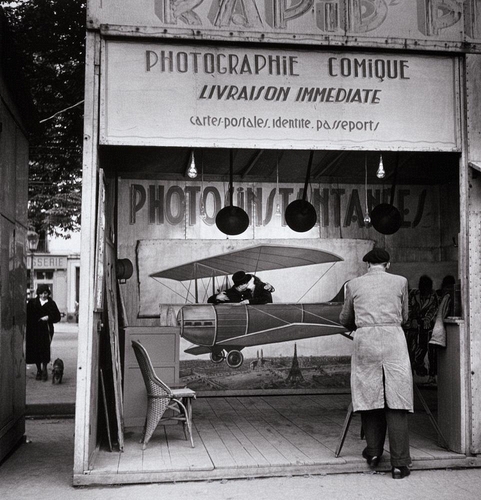
Robert Doisneau, "Photographie Aerienne",1950, Gelatin silver print, 10 1/4 x 9 7/8 ins (26.04 x 25.08 cm) (overall), Nelson-Atkins Museum of Art, Gift of Hallmark Cards, Inc., Object number: 2005.27.2634
LL/81450
Throughout the many histories of photography models have been used as the basis for photographs. At first the photographs were the documentation of architectural models and plans but they've evolved into specially built environments as in the works of Lori Nix, Carl Zimmerman and Paolo Ventura. Others such as Laurie Simmons and David Levinthal have used toys to create worlds addressing social and historical issues. Swiss based artists Jojakim Cortis and Adrian Sonderegger create detailed models of iconic photographs and then rephotograph the models showing the studio surroundings.
There are threads that run throughout photohistory that take time to unravel and Luminous-Lint brings these into increasingly coherent and comprehensible patterns.
Experimental & Manipulated Photography |
One aspect of Experimental & Manipulated Photography is "Trick Photography" and several excellent books were published on this in the early years of the twentieth century. The best known of these is the 1905 volume Photographic Amusements including a Description of a Number of Novel Effects Obtainable with the Camera by Walter E. Woodbury and fortunately it is available online.
Each of the illustrations in the Woodbury volume is included on Luminous-Lint along with original photographs that applied the various techniques providing a visual typology of all forms of trick photography.
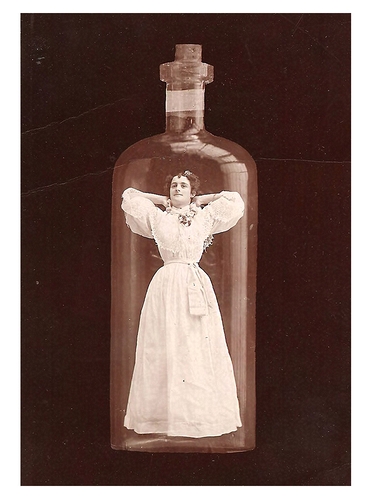
Unidentified photographer, "A woman in a bottle", n.d., Albumen print, photomontage, Carnegie Museum of Art, Gift of Robert Yoskowitz, 2017.63.8
LL/82407
Experimental & Manipulated Photography goes way beyond trick photography though and many other techniques and approaches are discussed on Luminous-Lint including cameraless photographs including photogenic drawings and photograms, chemigrams, solarization, distortions, photomontage, mixed media, the use of body fluids and many others.
Archaeological Photography |
The realization that photography could be applied to archaeology was appreciated from the first announcement of its invention.
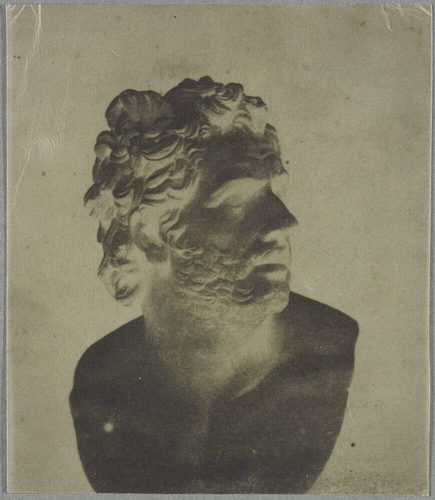
Henry Fox Talbot [Attributed to], "Bust of Patroclus", n.d., Paper Negative, camera, 15 x 13 cm, National Science and Media Museum, 1937-2688, Schaaf no. 1468
LL/82173
Henry Fox Talbot included a print of a bust of Patroclus pointing out in the Pencil of Nature (1844) how the camera could capture a statue in diverse ways:
These delineations are susceptible of an almost unlimited variety: since in the first place, a statue may be placed in any position with regard to the sun, either directly opposite to it, or at any angle: the directness or obliquity of the illumination causing of course an immense difference in the effect. And when a choice has been made of the direction in which the sun's rays shall fall, the statue may be then turned round on its pedestal, which produces a second set of variations no less considerable than the first. And when to this is added the change of size which is produced in the image by bringing the Camera Obscura nearer to the statue or removing it further off, it becomes evident how very great a number of different effects may be obtained from a single specimen of sculpture. (H. Fox Talbot, 1844, The Pencil of Nature, London: Longman, Brown, Green and Longmans)
Photography was used to document the sites of the Ancient and Classical Worlds for example Adolph Schaefer had daguerreotyped the Buddhist monument at Borobudur in Central Java, Indonesia in 1844-1845. Luigi Pesce took salt prints of the archaeological sites of Persia in the 1850s, Angkor was photographed by John Thomson and later by Emile Gsell and numerous photographers visited the remarkable sites of India.
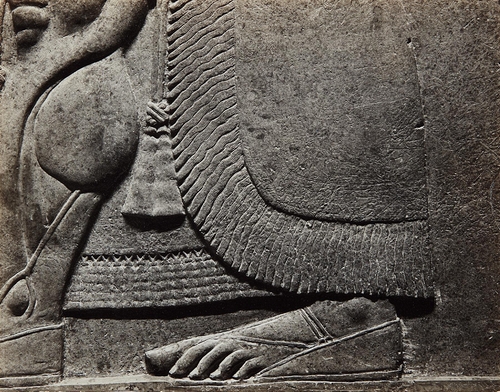
Charles Sheeler, Untitled (Neo-Assyrian relief panel from the collection of The Met, detail), 1942, Gelatin silver print, 7 1/2 x 9 1/2 in. (19.1 x 24.1 cm), Phillips - New York, "The Odyssey of Collecting: Photographs from the Joy of Giving Something Foundation", 3 October 2017, No. 164
LL/77733
Besides the sites themselves archaeologists appreciated the value of photography in capturing the details of sculpture, bas-reliefs, inscriptions and paintings that could be recorded far more quickly, and potentially more accurately, than by artists' sketches and drawings. There are also photographs of excavations in progress and of aerial surveys seeking out new sites.
The Photographs of Eugene Atget |
On Luminous-Lint there is a highly detailed examination of how photographers have documented Trees since the earliest days of photography. This study of the natural world is illustrated by over 1,100 of the finest photographs from around the world.
For some photographers entire series and monographs have been dedicated to their studies of trees and this is the case with Eugène Atget (1857-1927) written by Sylvie Aubenas & Guillaume Le Gall, 2003, Eugène Atget's Tree, (New York: D.A.P.). There is also a 2008 comparative collection of the photographs of Eugène Atget and Lee Friedlander in the book Parks and Trees: Eugène Atget & Lee Friedlander, (Cologne: Galerie Thomas Zander). Although better known for his documentation of the city streets, shops and parks of Paris his tree studies can be magnificent and there are twenty nine examples on Luminous-Lint.
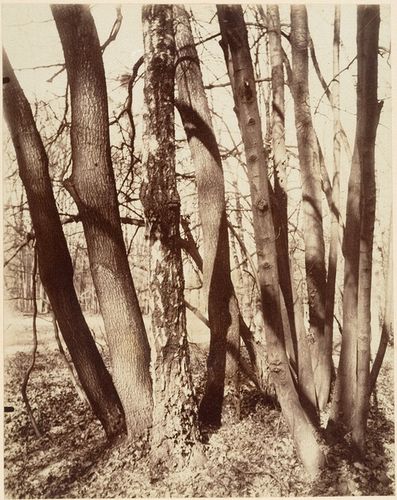
Eugène Atget, "St. Cloud, Fin mai, 7 h. soir", 1922, May, Albumen silver print, from glass negative, 21.9 x 17.3 cm (8 5/8 x 6 13/16 ins) (image) 35.4 x 28.6 cm (13 15/16 x 11 1/4 ins) (mount), Metropolitan Museum of Art, Gilman Collection, Gift of The Howard Gilman Foundation, 2005, Accession Number: 2005.100.519
LL/40393
If you have additional examples in your own collections please let me know.
Geocoding stores geographic coordinates (like latitude and longitude) to allow sites and items to be located on maps. There have been multiple geocoding projects addressing photohistory and this is now being implemented throughout Luminous-Lint. This will be a multi-step process working down a hierarchy from Themes, to Fragments, to Visual Indexes and finally individual photographs. This will take years but the final result will be global maps that can highlight individual locations with the most significant photographic images related to them.
It is a work in progress but like the PhV (Photohistory Visualizer), already on Luminous-Lint, it will reveal different ways of navigating through photohistory in profound ways.
If you have experience to share on geocoding get in touch.
So who has been involved in Luminous-Lint to date? |
Given the scale of Luminous-Lint it is difficult to remember all the names of those who have helped in ways both large and small. Having said that one should always try so I‘ve added an "Acknowledgements" page to get the ball rolling. As you go through it you will get a sense of the truly international scope of this project.
My gratitude to you all for subscribing to, and supporting, Luminous-Lint.
Free Trial of Luminous-Lint |
A FREE TRIAL for the website is currently available so send an email to alan@luminous-lint.com with your name and reasons for wanting to take a look and I'll set up a password for you.
  
Educational subscriptions |
It is time to ensure that your subscription to Luminous-Lint has been confirmed. Please check with whoever manages subscriptions to digital resources to ensure all is well. If you are a professor, researcher or student requiring access to Luminous-Lint please contact your head of department or librarian.
If you need any assistance with curriculum planning or resources to supplement your courses send me an email.

The following Themes have just been updated.
Anthropology and ethnology
Archaeology
Architecture
Arctic
Art
Australia
Awards and medals
Backgrounds and foregrounds
Back
Belgium
Boats, canoes and kayaks
Botany
Cabinet cards
Calotypes
Card photographs
Chairs and sofas
Characters and occupational types
Christian architecture
Christianity
Colonialism
Colour
Columns, plinths and pedestals
Composition
Daguerreotypes
Dancers
Dating photographs
Egypt
Evidence
Exhibitions and competitions
Experimental and manipulated photography
Exteriors of photographic studios
Fabricated realities
Flowers
Genre studies
Hand-painted photographs
History of photography
India
Indonesia
Islamic architecture
Islam
Israel and Palestine
Japan
Jerusalem
Kazakhstan
Lebanon
Marketing
Military
Musicians
Native Americans
New Zealand
Nuclear
Occupational
Occupations and roles
Orientalism
Painting on photographs
Panama
Paper and waxed paper negatives
Patents
Peoples of the world
Photochromes - Photochroms
Photogenic drawings
Photographic studios
Portrait
Prehistory of photography
Process and product
Props
Religions
Remnants of the Ancient and Classical world
Retouching, colouring and painting kits
Royalty
Sailing ships
Salt prints
Sample books and sample boards
Second World War (1939-1945)
Sedan chairs - Kago
Social life of photographs
Social outsiders
Stereoviews, stereographs and stereocards
Street photographers
Sudan
Syria - Syrian Arab Republic
Thailand
The Pyramids and the Sphinx
Tintypes
Travel
Turkey
Typologies
Uzbekistan
Water transportation
World"s Fairs and International Exhibitions
If you have suggestions for examples and subjects that should be added please let me know.
|
|

